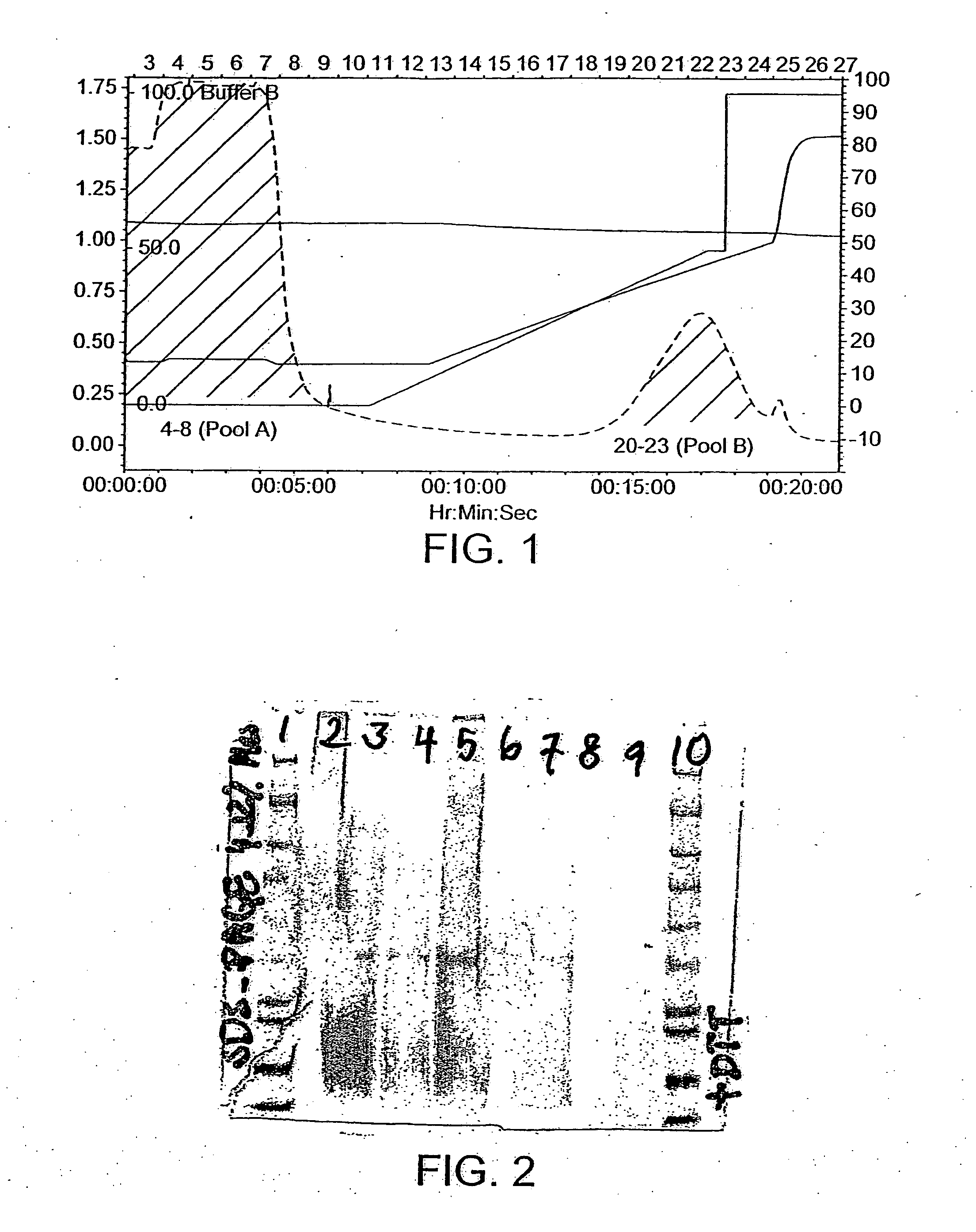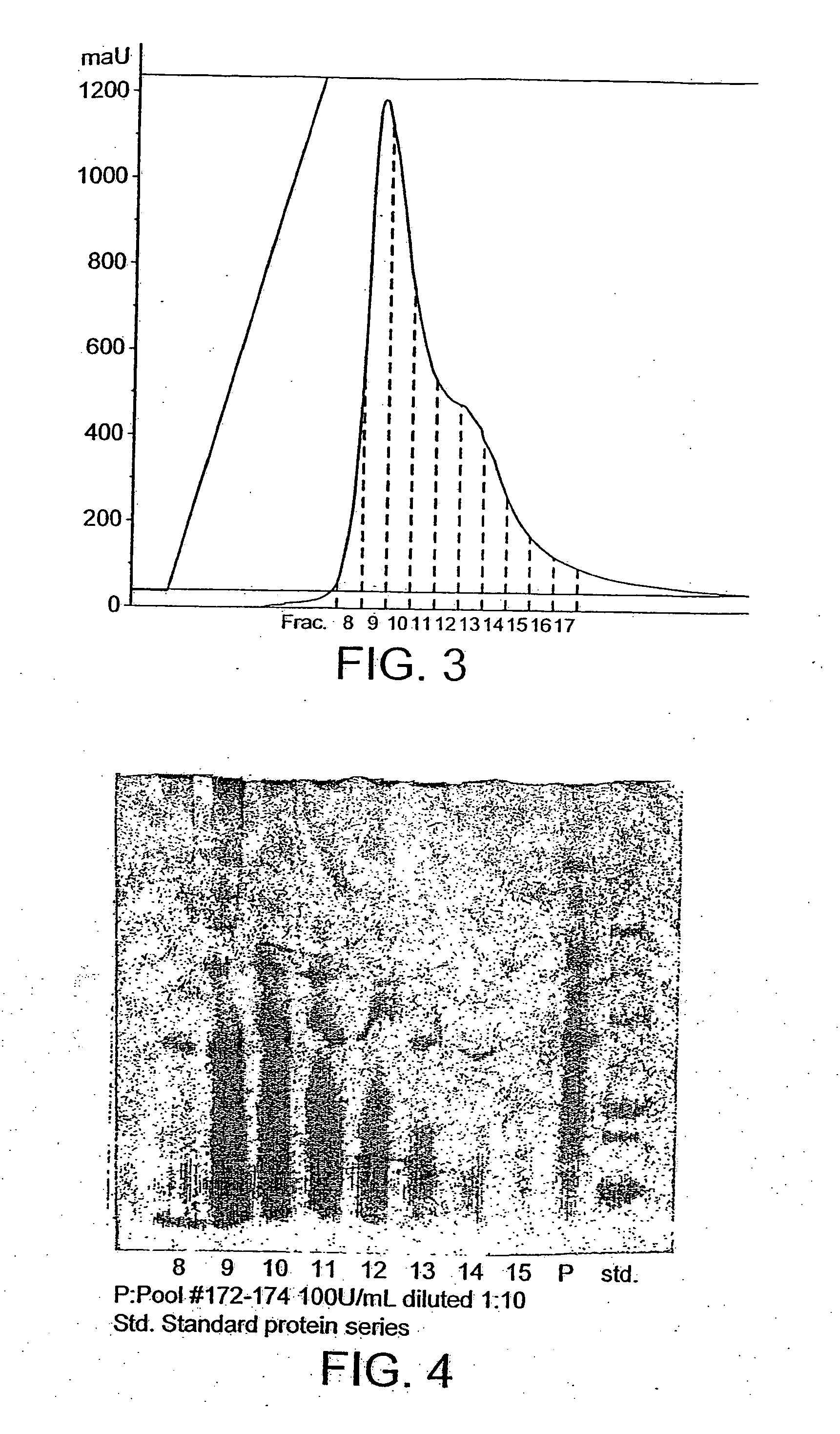Protein
a lipolytic enzyme and fungal technology, applied in the field of new fungal lipolytic enzymes, can solve the problems of reducing the elasticity of gluten, reducing the functionality of lipolytic enzymes, and affecting the functionality of foodstuffs, and achieves a high activity ratio and enhanced activity on the polar lipids
- Summary
- Abstract
- Description
- Claims
- Application Information
AI Technical Summary
Benefits of technology
Problems solved by technology
Method used
Image
Examples
example 1
Expression, Purification, Sequencing and Baking Trials of a Fusarium heterosporum Lipolytic Enzyme
[0393]Fusarium heterosporum CBS 782.83 strain was obtained from Centraalbureau voor Schimmelcultures (the Netherlands).
Growth mediaGlucose-yeast extract agarYeast extract 4 g / LKH2PO4 1 g / LMgSO4, 7H2O0.5 g / L Glucose15 g / LAgar20 g / L
[0394] Glucose was added after autoclaving
[0395] 1.4 Pre-Fermentation Medium
Soy flour50 g / L Glucose monohydrate50 g / L KH2PO42 g / LNa2HPO43 g / LSoy oil1 g / L
[0396] The medium was prepared in 500 mL shake flasks with baffles and 100 mL was added pr shake flask. The soy oil was added to each flask separately.
[0397] Glucose was added after autoclaving.
Production mediumPeptone10 g / LTween TM-8012 g / LMgSO4, 7H2O 2 g / LCaCl2, 2H2O0.1 g / L
[0398] The medium was prepared in 500 mL shake flasks with baffles and 100 mL was added pr shake flask. The Tween TM-80 was added to each flask separately.
[0399] pH was adjusted to 6.0 before autoclaving.
Culture C...
example 2
Construction and Expression of a Synthetic Gene Encoding a Lipolytic Enzyme from Fusarium heterosporum (CBS 782.83) in Hansenula polymorpha
[0443] The amino acid sequence of a fungal lipolytic enzyme isolated from Fusarium heterosporum (CBS 782.83) was determined and used to design and clone a synthetic lipolytic enzyme gene for expression in Hansenula polymorpha. To favour high expression, the codons of the synthetic gene were optimised to be in accordance with the codon preferences of Hansenula polymorpha. A codon optimised alpha-factor signal sequence was synthesised as Well and cloned in front of the synthetic lipolytic enzyme gene. The assembled construct was transferred into the expression vector pB14 and transformed into Hansenula polymorpha. pB14 is a plasmid without genes conferring antibiotic resistance and can therefore be used in production facilities.
[0444] A number of lipolytic enzyme producing Fusarium strains were screened for activities with a high ratio of activit...
example 3
Expression of a Fusarium heterosporum CBS 782.83 Lipolytic Enzyme in Hansenula polymorpha and Characterization of the Product in Baking Trials
[0460] The Hansenula polymorpha strain B14:8-3, 8 (DCDK0172), containing a lipolytic enzyme-encoding gene from the filamentous fungus Fusarium heterosporum CBS782.83, was fermented in the fed-batch mode. After 160 hours of fermentation the phospholipase activity reached 1200 U / mL. Based on the fermentations three products were made and tested further. The products are named the following: sample 205, −206 and −209.
[0461] A lipolytic enzyme sample 205 from F. heterosporum expressed in H. polymorpha was tested in miniscale baking experiments. Dough from the baking experiment was analyzed by GLC and HPTLC.
[0462] The baking results from mini scale baking confirm a very strong improvement of lipolytic enzyme sample 205 on bread volume and improvement of crumb structure. Lipolytic enzyme analysis confirmed a strong hydrolytic activity of lipolyti...
PUM
| Property | Measurement | Unit |
|---|---|---|
| pH | aaaaa | aaaaa |
| volume | aaaaa | aaaaa |
| temperature | aaaaa | aaaaa |
Abstract
Description
Claims
Application Information
 Login to View More
Login to View More - R&D
- Intellectual Property
- Life Sciences
- Materials
- Tech Scout
- Unparalleled Data Quality
- Higher Quality Content
- 60% Fewer Hallucinations
Browse by: Latest US Patents, China's latest patents, Technical Efficacy Thesaurus, Application Domain, Technology Topic, Popular Technical Reports.
© 2025 PatSnap. All rights reserved.Legal|Privacy policy|Modern Slavery Act Transparency Statement|Sitemap|About US| Contact US: help@patsnap.com



